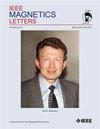用聚乳酸和回收的Nd-Fe-B纳米晶粉末制备用于粘结磁体增材制造的即用复合熔融沉积建模长丝
IF 1.1
4区 物理与天体物理
Q4 ENGINEERING, ELECTRICAL & ELECTRONIC
引用次数: 0
摘要
熔融沉积建模(FDM)是一种增材制造技术,已广泛应用于许多工程领域,最近被证明适用于生产复杂的网状粘结钕铁硼磁体。与此同时,回收废弃磁铁已经成为一个新兴的问题,因为它们在当前技术中的存在越来越多,而且稀土元素(如钕和镨)的内在稀缺性。在这里,我们研究了利用氢化-歧化-解吸-重组(HDDR)工艺获得的回收纳米晶Nd-Fe-B粉末制备FDM原料和随后打印磁性部件的可行性。将回收的磁粉与聚乳酸混合,挤压成含有越来越多磁粉体积分数的长丝。可以得到体积为6.7% ~ 23.6% (30.4% ~ 65.2 wt.%)的磁粉,可以打印零件,最大矫顽力(Hcj)达到707.7±3.5 kA/m,最大剩磁(Br)达到84.5±0.4 mT,最大能量积(BHmax)达到1.3 kJ/m3,平均零件孔隙率为42±8%。与回收粉末(750±75 kA/m)相比,打印部件的矫顽力损失约为8.6%。老化实验表明,这种损耗可能是增材制造过程中磁性颗粒的热效应和氧化效应的共同作用。目前的工作已经证明了即用型、高矫顽力FDM长丝的成就,以及使用回收的Nd-Fe-B HDDR粉末的3d打印部件。本文章由计算机程序翻译,如有差异,请以英文原文为准。
Ready-to-Use Composite Fused Deposition Modeling Filaments Produced With Polylactic Acid and Recycled Nd–Fe–B Nanocrystalline Powder for Additive Manufacturing of Bonded Magnets
Fused deposition modeling (FDM) is an additive manufacturing technique that has become widely used in many fields of engineering and has recently proven to be suitable for producing complex, net-shaped bonded Nd–Fe–B magnets. At the same time, recycling end-of-life magnets has been an emerging concern due to their increasing presence in current technologies and the intrinsic scarcity of rare-Earth elements, such as neodymium and praseodymium. Here, we investigated the feasibility of using recycled nanocrystalline Nd–Fe–B powders, obtained from a hydrogenation–disproportionation–desorption–recombination (HDDR) process in the preparation of FDM feedstock and subsequent printing of magnetic parts. Recycled magnetic powder was mixed with polylactic acid and extruded into filaments containing increasing volume fractions of magnetic powder. It was possible to obtain filaments containing from 6.7% to 23.6% in volume (30.4 to 65.2 wt.%) of the magnetic powder, from which parts could be printed, reaching maximum coercivity (Hcj) of 707.7 ± 3.5 kA/m, maximum remanence (Br) of 84.5 ± 0.4 mT, maximum energy product (BHmax) of 1.3 kJ/m3, and average part porosity of 42 ± 8%. Coercivity loss of about 8.6% was observed in the printed parts compared to the recycled powder (750±75 kA/m). Aging experiments showed that such loss may be a combined effect of thermal and oxidation effects of the magnetic particles during the additive manufacturing processing. The present work has demonstrated the achievement of ready-to-use, high-coercivity FDM filaments, and 3-D-printed parts using recycled Nd–Fe–B HDDR powders.
求助全文
通过发布文献求助,成功后即可免费获取论文全文。
去求助
来源期刊

IEEE Magnetics Letters
PHYSICS, APPLIED-
CiteScore
2.40
自引率
0.00%
发文量
37
期刊介绍:
IEEE Magnetics Letters is a peer-reviewed, archival journal covering the physics and engineering of magnetism, magnetic materials, applied magnetics, design and application of magnetic devices, bio-magnetics, magneto-electronics, and spin electronics. IEEE Magnetics Letters publishes short, scholarly articles of substantial current interest.
IEEE Magnetics Letters is a hybrid Open Access (OA) journal. For a fee, authors have the option making their articles freely available to all, including non-subscribers. OA articles are identified as Open Access.
 求助内容:
求助内容: 应助结果提醒方式:
应助结果提醒方式:


